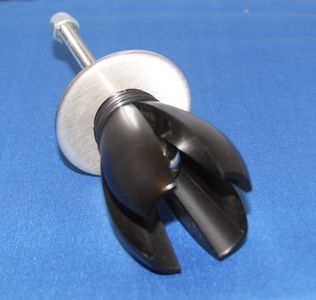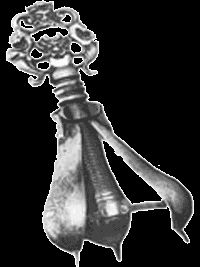Choke pear
A choke pear or chocky-pear is an astringent fruit. It is (the fruit of) any variety of pear that has an astringent taste and that is difficult to swallow. Similarly named trees with astringent fruits include the choke cherry (the common name for several species of cherry tree that grow in North America and whose fruits are small and bitter tasting: Prunus Virginiana, Prunus demissa, and Prunus serotina) and the choke plum.
One variety of choke pear is Poire d'Angoisse, a variety of pear that was grown in Angoisse, a commune in the Arrondissement of Nontron in Dordogne, in the Middle Ages, which was hard, bad tasting, and almost impossible to eat raw, without cooking it. In the words of L'Académie française, the pear is "si àpre et si revéche au goût qu'on a de la peine à l'avaler". Dalechamps has identified this with the species of pear that Pliny the Elder listed as "ampullaceum" in his Naturalis Historia.
A choke pear (and indeed a poire d'angoisse in French) is thus, metaphorically, anything that is difficult to swallow, or that stops up the mouth. It is anything that silences reply, or an argument that cannot be answered. Both "choke pear" in English and "poire d'angoisse" in French are thus colloquialisms for pear-shaped gags, such as used by criminals to silence their victims.
In the 16th century, the idea developed that a "choke pear" or "poire d'angoisse" was more than just a simple gag in the shape of a pear. Brewer's Dictionary of Phrase and Fable describes this more complex device as follows: "Robbers in Holland at one time made use of a piece of iron in the shape of a pear, which they forced into the mouth of their victim. On turning a key, a number of springs thrust forth points of iron in all directions, so that the instrument of torture could never be taken out except by means of the key."
More detailed versions of this story state that it was invented by a robber named Capitaine Gaucherou de Palioly in the days of Henry of Navarre, tracing this description to F. de Calvi's L'Inventaire général de l'histoire des larrons written in 1639, and state that the robbers were actually in Paris, not Holland. However, Eldridge and Watts, superintendent of police and chief inspector of the detective bureau in Boston, Massachusetts, writing in the 19th century, whilst accepting that ordinary pear-shaped gags exist, observed that contemporary robbers used no such device as Palioly's Pear and cast doubt upon its very existence in the first place, saying that "[f]ortunately for us this 'diabolical invention' appears to be one of the lost arts, if, indeed, it ever existed outside of de Calvi's head. There is no doubt, however, of the fashioning of a pear-shaped gag which has been largely used in former days by robbers in Europe, and may still be employed to some extent. This is also known as the 'choke-pear', though it is far less marvellous and dangerous than the pear of Palioly."
Chat rooms • What links here • Copyright info • Contact information • Category:Root


